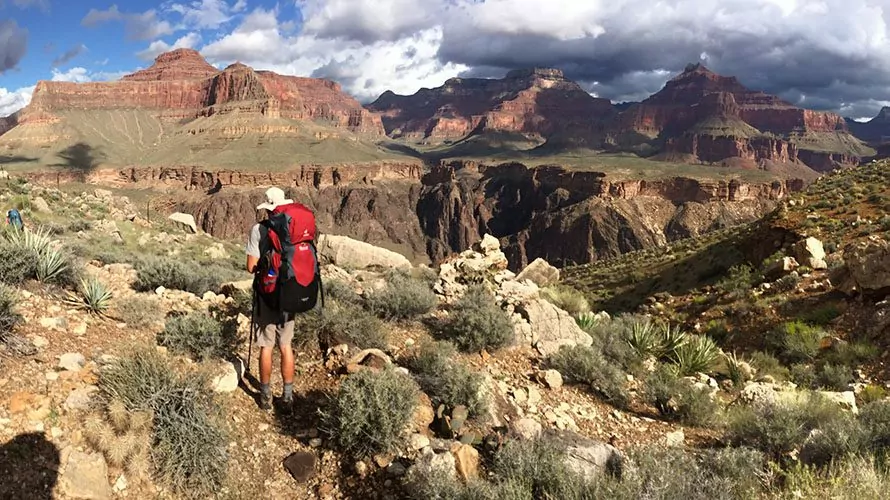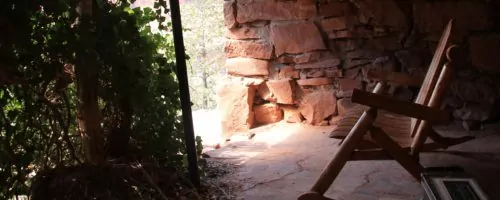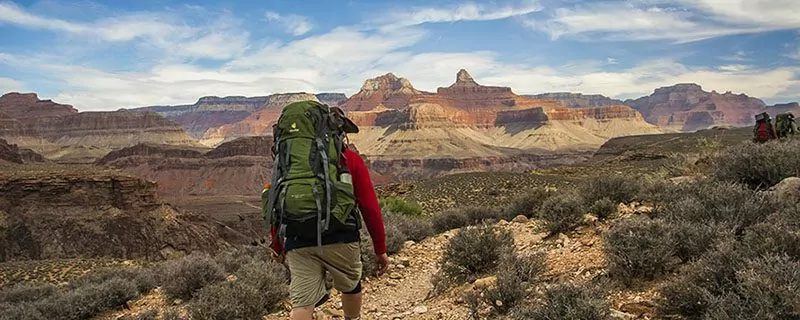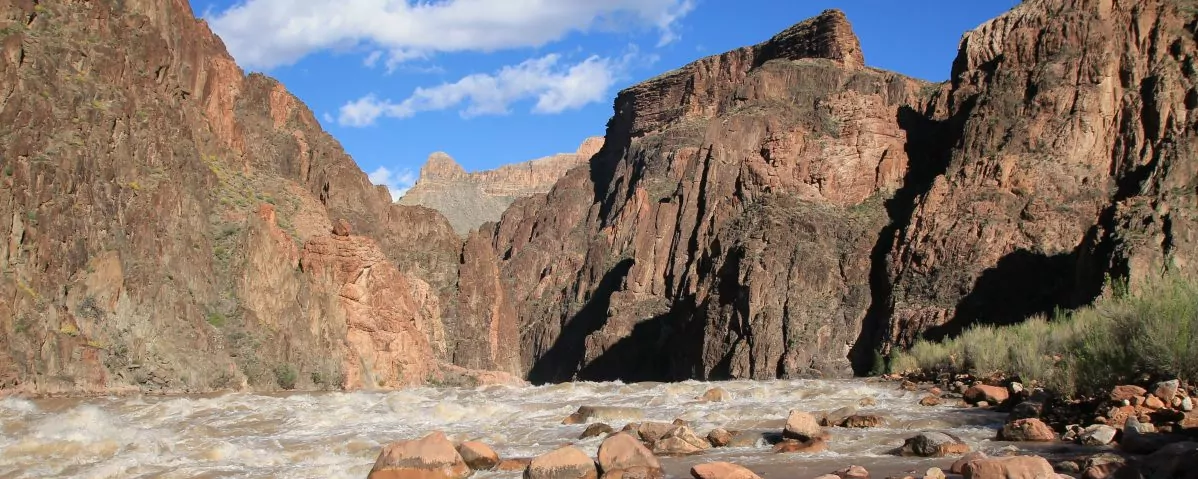
Hermit Trail
The Hermit Trail is a steep descent into a dramatic side canyon to the Colorado River with dizzying drop-offs and stunning views. The trail is well-maintained by the National Park Service. The upper section is steep, dropping 2,000 feet in the first two and a half miles. Much of the Coconino is cobblestone pathways created by hand-placed smooth rocks (a pro tip: keep the rubber tips on the end of your trekking poles in the cobblestone sections, that way the ends don’t get stuck in between the rocks). Between Santa Maria Spring and the Cathedral Staircase, hikers will traverse long sections, weaving in and out, of the Supai formation. Once at the Cathedral Staircase, the descent is unforgiving, as a series of switchbacks take you down the Redwall quickly. Hermit Trail continues another mile and a half down to the Colorado River, where hikers and backpackers will be rewarded by getting up close and personal with one of the larger rapids on the river. This trail offers incredible, panoramic views of the canyon, opportunities to explore the historic Hermit Camp and walk on original cobblestone paved paths, and experience the grandiosity of the Colorado River at Hermit Rapid.
History of the Hermit Trail
The Hermit trail along with Hermits road and Hermit rest is named after Louis D. Boucher (pronounced Boo-Shay) who was a French Canadian trapper/miner who lived near Dripping Spring. Boucher acquired his nickname because he lived alone in the Grand Canyon for 20 years, despite being a sociable character. He was a important part of the South Rim community and later became a guide for the Hermit Camp. Like most trails in the Grand Canyon, the Hermit Trail was originally a Native American route used for Ancestral Puebloans and later the Havasupai to gather plants and hunt animals.
The trail was formally built by the Santa Fe Railroad for the Fred Harvey Company to access the Hermit Camp, situated on the Tonto formation. The camp was built in the 1910s and included a tramway into the canyon, a fully functioning automobile, and high-end canvas cabins for wealthy patrons. Hermit Camp was very successful for about 20 years, but was shut down in the early 1930s so the National Park Service could focus it’s efforts on Phantom Ranch. It was abandoned and all that remains of the Hermit Camp are building foundations, an underground cellar, a mule corral and relics from that era– which can all be seen from the trail. In the 1970s, when hiking and backpacking became more popular, the National Park Service repaired the trail and made improvements while keeping the historic cobblestone pathways in good condition.

3 Best Day Hikes on the Hermit Trail
The Hermit Trail offers wonderful day hiking options and is a much quieter trail than the busy Bright Angel or South Kaibab trails.
Below are the primary options for day hiking the Hermit Trail:
| Destination | Miles Round Trip | Elev | Difficulty | Style | |
| Santa Maria Spring | 4.4 mi | 1,640 ft | Moderate-Strenuous | Out and Back | |
| Dripping Spring | 7 mi | 1,240 ft | Moderate-Strenuous | Out and Back | |
| Breezy point | 11 mi | 2,220 ft | Strenuous | Out and Back |
1. Santa Maria Spring
To reach Santa Maria Spring, you will drop 1640 ft in 2.2 miles. The trail is rocky and steep, so trekking poles are recommended. As with all Grand Canyon trails, the difficulty of the hike will be determined by the time of year you decide to go, as summer temperatures often exceed 100 degrees fahrenheit. The trail will start out in a small pygmy forest which quickly gives way to great views of the Hermit Basin and Waldron Canyon. When you reach the Coconino sandstone, you will see the intricate historic trail construction. The trail will flatten out once on the Supai formation and you will have good break spots under the pinyon pines and juniper trees. Once ready, continue down the Hermit Trail to the Santa Maria shelter which offers great shade and a permanent water source which you can use to replenish your thirst and reservoirs, only after filtering or treating the water. After enjoying the shade and signing the hikers log in the ammo can, return to the South Rim the same you came.
2. Dripping Spring
To reach Dripping Spring, you will start your hike down the Hermit Trail (see description above), after 1.5 miles, look for the junction for Dripping Spring. The trail will leave the Waldron Basin and head west along along the Supai formation. You will be hiking along a cliff’s edge with big drops-offs, therefore hikers with vertigo should take extra care in this section. The views are absolutely stunning; looking up to your left you will see the massive sheer walls of the Coconino sandstone and Kaibab limestone, which look like ancient walls to a fortress of long ago. After traversing the cliff’s edge, you will be hiking over boulder slides and slowly gain elevation to reach Dripping Spring.
The spring is marked by a sign and is a wonderful oasis inside the Grand Canyon. If hiking in springtime, the trees will be in full bloom, so you may forget that you’re in Arizona, leaving you to wonder if you’re in the Garden of Eden. This water source is not permanent, and it is recommended that you pack in enough water for the entire hike. When ready, return to the South Rim the same way you came. This is a great trail for those that want to see a less trafficked part of the canyon and will be rewarded with tremendous views.
3. Breezy Point
Breezy Point offers great panoramic views of the inner canyon gorge and is not much lower in elevation than Santa Maria Spring. It is, however, three miles farther, so if under taken as a day hike, it is only recommended for physically fit and prepared hikers. Again, you will want to get a early start to beat the heat if hiking in the summertime. Once past the Santa Maris Spring shelter, you will traverse the Supai formation for 3 more miles. This bends in and out and may seem to last forever before reaching your destination. The trail will traverse multiple rock slides where you will have to do some small trail finding. Once you reach Breezy Point, there are great places to eat lunch while you soak in the expansive canyon views. Breezy Point is a great destination for the determined hiker because you will experience amazing, jaw-dropping panoramas. To reach the South Rim return in which the way you came and remember to fill up on water at Santa Maria Spring.
Maximize Your Visit to Grand Canyon National Park on a Hiking Tour
Guided day hike tours and multi-day packages allow visitors the opportunity to make the most of their time in Grand Canyon National Park and to do it hassle-free. Guided tours include gear (backpack, trekking poles, crampons in winter), meals, accommodations on multi-day tours, local transportation, and a professional Grand Canyon hiking guide. Through their knowledge, stories, and personal passion, guides can bring a place to life in a way that’s much more difficult to do on your own. Read more about Grand Canyon Hiking Tours.

3 Hermit Trail Backpacking Trips
Backpacking on the Hermit Trail is tremendous because of the diversity that you can experience. The side canyons that surround the trail have steep and impressive walls and evidence of past rock slides with boulders the size of houses, and the accessibility of the Colorado River and some of the large rapids, make getting to the river so rewarding.
| Route | Miles | Difficulty | Campgrounds | |
| Hermit Rapid | 19.4 mi | Strenuous | Hermit Camp CG Hermit Rapid CG |
|
| Granite Rapid | 20.6 mi | Strenuous | Monument Creek CG Granite Rapid CG |
|
| Hermit Loop | 24.8 mi | Strenuous | Monument Creek CG Horn Creek CG or Havasupai Garden CG |
1. Hermit Trailhead to Hermit Rapid (2-3 days)
This is a spectacular backpacking trip because it gives you a chance to experience a huge part of human life in the Grand Canyon and development of trails. Get a glimpse into the past as you walk through time on your journey to one of the bigger rapids on the Colorado River. Strong backpackers can do the out-and-back trip in just two days, but if you want to take your time, it is recommended to do the trip in three days, so you have more time to explore. While at Hermit Campground, take time to check out the remnants of the historic Hermit Camp. You’ll be camping in either the Hermit Campground with its amazing sandstone walls and life-nourishing creek, or on the sandy beach of Hermit Rapid, enjoying the stars before being lulled to sleep by the roar of the mighty Colorado River.
2. Hermit Trailhead to Granite Rapid (3-4 days)
This trip is wonderful because it allows backpackers to view some of the best rapids accessible from the South Rim, some unique rock formations, and is a great trail to spot reptiles. You have the option to stay at Hermit Campground, Hermit Rapid, Monument Creek, or Granite Rapid, which will offer great diversity in a short amount of time.
From the Hermit Trail going to Granite Rapid, you will look for the trail junction pointing to Monument Creek, and begin your trek across the Tonto formation to your destination. Monument Creek is named after the unique pinnacles that surround the side canyon. The campground is beautiful with it’s sandstone walls and small, stunned trees with lush vegetation, keep an eye out for the collared lizard which stands on it’s hind legs and runs like a miniature Tyrannosaurus Rex when frightened. To get to Granite Rapid, follow the wash downstream to the river. It is another large rapid on the Colorado River and was formed by a flash flood in 1984, sweeping debris downstream and depositing it in the river. To finish this trip, return to the South Rim via the leg-burning, bum-busting Hermit Trail.
3. Hermit Loop (3-4 days)
This trip is done as a loop, with help from the free NPS shuttle buses. You will begin down the Hermit Trail, look for the junction sign pointing toward Monument Creek, and here you will begin on the Tonto formation. Camping is available at Monument Creek, Cedar Spring, Salt Creek and Horn Creek along the Tonto Trail.
You will continue on the long and beautiful Tonto Trail until arriving at Havasupai Garden. There is an option to stay here for a night, and if you do, it is well worth it to wake early for sunrise and watch the canyon come to life at the panoramic Plateau Point. The last leg of this trip is up the busy Bright Angel Trail, that tops out at the famous South Rim Village. It is here that you can catch a shuttle bus back up to the Hermit Trailhead for your car. This trip offers amazing views of the canyon, vistas of the Colorado River, big rapids, plethora of plants, and a chance to spot wildlife such as the California Condor, and ringtail cat. The trip can also be done in the reverse direction.
Join a Guided Grand Canyon Backpacking Trip
Joining a Grand Canyon backpacking tour is a worry-free, adventurous way to experience [national park]. With your gear, meals, local transportation, permits, and fees taken care of for you, you can travel light and focus 100% on enjoying the hiking experience, while the guide company takes care of everything else. Also, by going with local experts you’ll enjoy a greater level of safety and gain a much better understanding of the history and ecology of this remarkable region. Read more about a guided Grand Canyon backpacking trips.

When to Hike and Seasonal Considerations
The Grand Canyon gets hot, super hot, in the summer. Be sure to check the weather before you head out on any trail.
Necessary Permits
Day Hike Permits
Permits are not required for day hikes in Grand Canyon National Park.
Backpacking Permits
Visitors are required to obtain permits if camping anywhere besides the established campgrounds on the rim of the canyon. It’s important to not attempt to hike and camp inside the Canyon without the necessary Grand Canyon backpacking permits. For permit information at the Grand Canyon, click here.
Getting to the Hermit Trailhead
Getting to the Hermit Trailhead can be a little tricky. The first thing to know is that the Hermit Road is only open to private vehicles from December to February. From March 1st to December it is closed to visitors driving their own cars. You may ride one of the NPS free shuttle buses that leave every 15 minutes, and have pick up stops by the visitor center and various locations in the village. The buses make numerous stops at the scenic viewpoints on the seven-mile long Hermit Road. The last stop is at Hermit’s Rest, and the trail head is located about 300 yards at the end of the dirt road located next to the bathrooms and water refill station. If you acquire a backcountry permit, you can may get permission to drive the road yourself. Another way to gain access to the trailhead is by hiring a taxi from Xanterra. Keep in mind the National Park service closes Hermit Road due to heavy snow, lightning, and other bad weather.
Suggested Packing List
Day Hike Packing List
- 3-6 liters of water (more in summer)
- salty, calorie-rich snacks
- lunch
- backpack
- trekking poles
- crampons (in winter)
- wide-brimmed hat
- sunscreen, sunglasses
- non-cotton t-shirt
- rain jacket
- warm non-cotton layer
- 1st-aid kit
Backpacking Packing List
- all items listed for day hikes PLUS
- multi-day backpack
- 3-season tent
- sleeping bag
- sleeping pad
- headlamp
- water filter
- backpacking stove and fuel
- backpacking meals
- 3 pairs wool socks
- animal-proof food storage containers
Please Respect Our National Parks – Leave No Trace
We strongly recommend abiding by all Leave No Trace ethics guidelines and practices so that our national parks and public lands are preserved for the enjoyment of future generations and for the people and animals who call these places home. Simple things like packing out your trash, obeying national park rules, and respecting the peace and quiet of our national park trails is a great start. If you’re going on a backpacking trip, you can read about more about the 7 Leave No Trace Principles.




